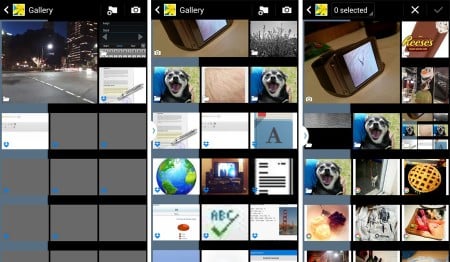Moving to the multimedia side of things, and the Note 3 appears to be a decent tablet replacement, which given its size, doesn’t surprise us in the slightest.
Samsung’s music sharing Group Play is on this device, as is the S Health and S Translator apps, but you’ll also find the TV friendly “WatchOn,” working in collaboration with the infrared controller at the top of the device, turning the smartphone into a TV remote.
Samsung’s choice of camera in this handset reminds us very much of what it threw into the Galaxy S4, and that can only be a good thing. Both have the same megapixel counts, but there are some differences here and there.
Like the S4, you’ll find the erasing mode which fires a few frames and lets you cut out parts of the background you may not want, as well as a “sound & shot” mode which records up to nine seconds of audio when an image is captured.
These are neat modes, but require you to be in the modes to use them, which is different from HTC’s decision on the matter which only requires you use HTC’s enhanced camera mode “Zoe” and then run whatever edits you prefer later.
There’s also a mode that makes use of an Android 4.2 feature that’s been missing on all but the Google devices, and that’s the photosphere mode, called “surround shot” on the Galaxy Note.
It won’t be a camera feature all will use, but it’s a fun little one that allows you to take multiple pictures of a room, mapping the entire space to a 3D object that you’re standing in. It’s essentially virtual reality for your phone, even if it also isn’t, and we had mixed opinions on the inclusion with this one, though it is neat.

The front-facing camera has also added a face smoothing feature, so you can iron out those wrinkles in selfies, while another distinction from the S4’s camera is the inclusion of 4K support over on the video camera side of things.
This feature is a new one for us in Australia, and even though Acer announced it at IFA earlier in the year, nothing has arrived locally showing it. Samsung’s Note 3 does have this technology, however, and after testing it, we found it allows you to capture videos in Ultra HD, also known as the 4K standard.
Unlike when you record in Full HD, you’ll find no optical image stabilisation or image taking while the video is being shot, but at least it’s something, and if you have invested in a 4K TV, this will provide you with a 4K camera in your pocket well before most camera manufacturers provide the capability in their own dedicated imaging devices.
Something else the Note 3 has that is quite cool is one that most people won’t see coming: USB 3.0 support.
At the bottom of the handset is what appears to be a new port, and it might have you banging your head against a wall yelling “not another bloody proprietary format.” We say it might because if you know your stuff, it won’t, as this port is actually the USB port used on USB 3.0 devices.
Hard drives supporting this format have been out for a few years now, and we’ve even seen an accessory here and there sporting the high-speed connection. Appearing in the Samsung Galaxy Note 3, we can see the obvious use will be moving large files to and from the device, and since this smartphone supports the shooting on 4K videos, it makes this port even more logical.
It’s also worth noting that the USB 3.0 port is made up two distinct connectors, a big one that most people know as microUSB that appears on most smartphones (everything but the iPhone, in fact), and a smaller version of the microUSB that looks linked. On a hard drive, these two connections make up the data and power transfer side of things, but just because they appear on the Galaxy Note 3 doesn’t mean you’re forced to use a new cable. In fact, you can charge the Note 3 using your old microUSB power cables all the same, or switch to the new format.
One neat bonus is included in the box, though, and that’s an extra long USB 3.0 cable, which you can use with the smartphone, or as an extra long cable for your external USB 3.0 hard drives.
We’re sure you’ll appreciate it. We sure did.
What’s interesting about all these features is it seems like Samsung has paid more attention with this product than with any other smartphone before it. It’s the third Galaxy Note, and yet it feels more whole than the fourth version of the Galaxy S smartphone, and that wasn’t a bad phone either.
Despite this, however, Samsung doesn’t totally nail the formula, and still leaves a few bugs laying around.
We got over the continued use of plastics in the design of the Note 3, but the one thing that has us stumped in design is the is the fake stitching on the back, designed to make people think the phone has a proper leather back complete with stitching. The problem with this is that you know it’s fake, and it feels it too.
We can get over this design aspect, though, because it’s not nearly as irritating as some of the bugs still present in the Australian incarnation of the Note 3 version of Android.
Samsung has gone and brought this device up to the very recent version 4.3, which is nice of it, but Australia — and likely other regions of the world — sees a version of the operating system that comes with a few limitations and bugs that may, well, bug you, so to speak.

We’ve seen these in all the other Galaxy products this year, and the Note 3 is no different, including the gallery bug that causes the image gallery to have such a dramatic slow down that you’ll be lucky to see the gallery load rather than give off the appearance that it’s crashed, only to load just as soon as you’ve hit the back button.
It’s a frustrating bug that hasn’t been patched yet and is present on the S4, S4 Active, and Mega devices.
Also not patched is the shortcut dock at the bottom of the screen, and while other nations will likely get a Note 3 that let them change the icon dock to feature apps they use — maybe Twitter and Chrome replacing contacts and the stock internet browser — Australians aren’t so lucky, and like we said in the Mega review (which features the same bug), we hope you like phone, contacts, messages, and the basic internet browser, because you can’t change them here.

Finally, the camera can’t be silenced at all, and makes a very audible click every time you fire off a shot.
Some readers have told us this is probably a legal requirement, but given that other manufacturers aren’t requiring it — including Apple and LG — we’re not so sure. You can, if you want, replace the dedicated camera app with one that lets you silence it, but Samsung’s one features all the neat camera modes, and it will keep on telling everyone that you’re taking a picture.
Conclusion
Lots of people are using big phones out there, and they have Samsung to thank. The company practically invented the space known as “phablets” when it first launched the Galaxy Note, and now in its third iteration, we’re seeing what is close to a perfection of that concept.
There is so much about the Note 3 that is excellent, from the fast processor, excellent download speeds, solid battery life, lovely screen, top camera, improved pen support, and a smattering of bits and bobs here and there that make it feel like Samsung has crafted something that won’t just last to the end of the year, but also to the end of the next couple.
Not everyone will desire a big phone, that said, but if you do, and if you truly want a larger smartphone experience that has so much going for it, you need to put the Galaxy Note 3 in your hands.















































We will check with Samsung on this, though it’s also telco dependent. Who are you with?
It’s an unlocked phone but it’s got a Telstra sim card. I really appreciate your looking into this.
We’re checking with Samsung. So far, no sign, but we’ll update this thread when it gives us a firm date.
Thanks so much for that.